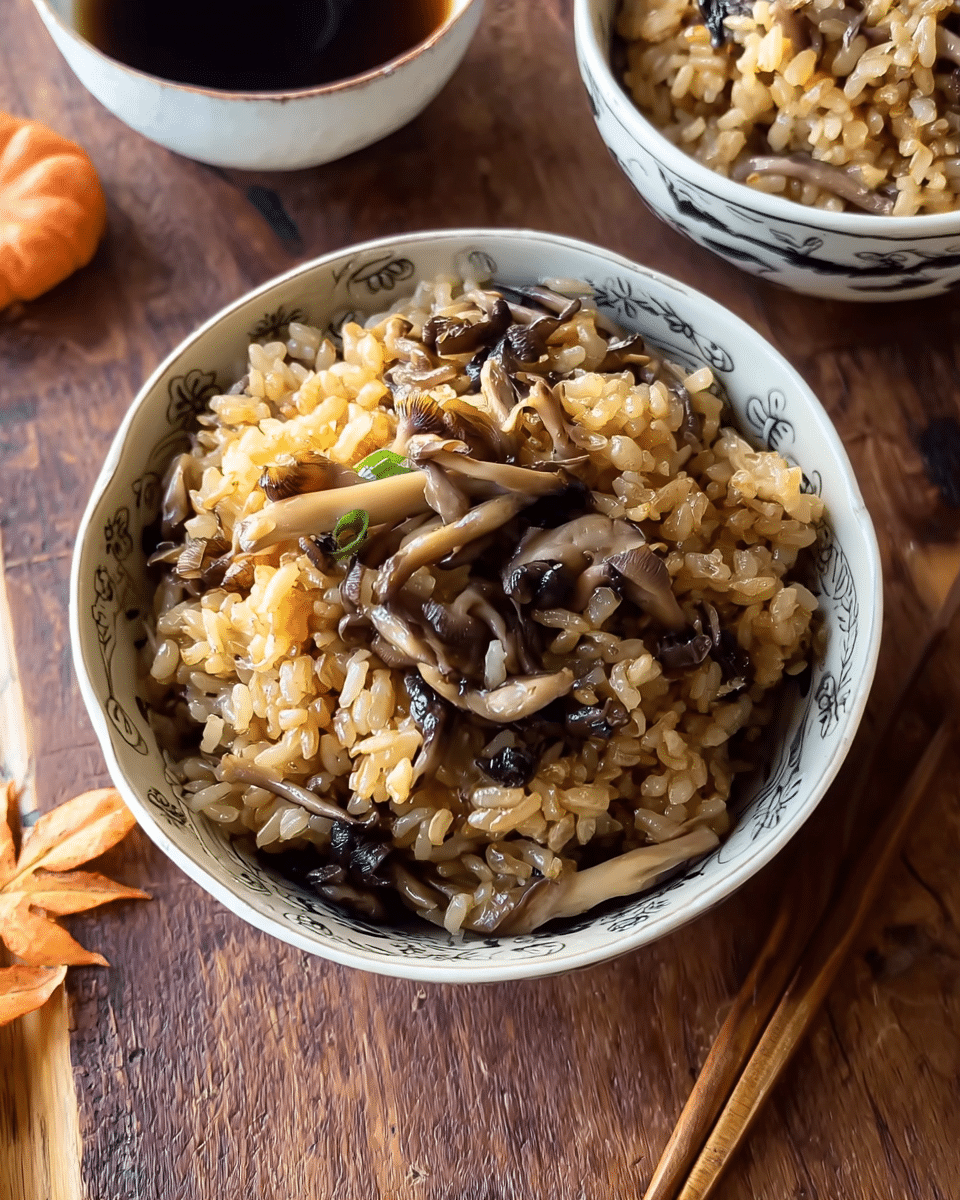Japanese Mushroom Rice, or Kinoko Gohan (きのこご飯), is a savory, umami-packed dish made with a variety of mushrooms, rice, soy sauce, and shio kombu. The combination of earthy mushrooms and sticky rice makes it a comforting and flavorful meal. This dish, often made with shiitake, maitake, or shimeji mushrooms, is perfect for any occasion, especially during autumn when mushrooms are in season.
Full Recipe:
Ingredients
-
1 lb (450g) mushrooms (shiitake, maitake, shimeji, or a mix)
-
2 cups (300g) Japanese short-grain rice
-
2 tbsp shio kombu (or 3 tbsp katsuobushi or 2 tsp dashi powder as substitutes)
-
2 tbsp soy sauce
-
2 tbsp mirin
-
2 tbsp sake (optional)
-
2 tsp sugar
-
5 dashes MSG (optional)
-
1/4 tsp salt
-
2 tbsp neutral oil (vegetable or similar)
-
Butter for serving (optional)
Directions
-
Prepare the Rice:
-
Rinse the rice thoroughly until the water runs clear, then soak for 30 minutes. Drain the rice afterward.
-
-
Cook the Mushrooms:
-
Heat 2 tbsp oil in a pan over medium-high heat. Add sliced mushrooms and half the shio kombu. Sauté until mushrooms are golden and slightly crispy, about 2-3 minutes on each side. Set aside.
-
-
Prepare the Rice Cooker:
-
Add the drained rice to the rice cooker. Pour in soy sauce, mirin, sake, sugar, the remaining shio kombu, MSG (if using), and salt. Add water up to the 2-cup line in the rice cooker. Stir gently.
-
-
Cook the Rice:
-
Place the sautéed mushrooms on top of the rice (do not stir in). Close the rice cooker lid and cook using the “mixed rice” or regular rice setting. Add 5-10 extra minutes if necessary.
-
-
Finish:
-
Once cooking is complete, let the rice steam for 10 minutes. Fluff the rice, then mix the mushrooms in. Optionally, serve with a dollop of butter on top for extra richness.
-
Nutrients (per serving)
-
Calories: 412 kcal
-
Fat: 10g
-
Saturated Fat: 3g
-
Carbohydrates: 69g
-
Fiber: 1.5g
-
Protein: 6.8g
-
Sodium: 1147mg
The Umami-Rich Flavor of Kinoko Gohan
The true essence of Japanese Mushroom Rice lies in its umami-rich flavor, which comes from the harmonious blend of ingredients like soy sauce, mirin, sake, and shio kombu. Umami, one of the five basic tastes alongside sweet, sour, salty, and bitter, is often described as a savory, deeply satisfying flavor that is characteristic of many Asian cuisines. In this dish, mushrooms naturally enhance the umami profile, while the other seasonings contribute to a balanced, comforting taste.
Mushrooms, especially varieties like shiitake, maitake, and shimeji, are known for their ability to absorb and release flavors, making them ideal for dishes that require a rich depth of taste. Their earthy flavor, combined with the slightly sweet and salty components from the soy sauce and mirin, creates a layered and satisfying taste experience. The addition of shio kombu or katsuobushi (dried bonito flakes) brings an extra layer of umami that elevates the dish.
The Role of Rice in Kinoko Gohan
Japanese short-grain rice is a critical component in creating the perfect texture and flavor in Kinoko Gohan. Unlike long-grain rice, short-grain rice has a higher starch content, making it sticky when cooked. This sticky texture allows the rice to absorb the flavors of the mushrooms and seasonings, resulting in a cohesive dish where the rice and mushrooms blend together in every bite. The rice also provides a neutral base that complements the rich, savory flavors without overpowering them.
When cooked in a rice cooker, the rice is infused with the umami of the mushrooms and seasonings, allowing each grain to soak up the sauce and seasonings. The result is a dish where the rice itself becomes as flavorful as the mushrooms, creating a balanced and delicious meal. This is one of the reasons why Kinoko Gohan is often considered a comfort food in Japan; the sticky rice and earthy mushrooms are deeply satisfying and comforting.
Choosing the Right Mushrooms
One of the distinctive features of Kinoko Gohan is the variety of mushrooms used in the dish. While shiitake mushrooms are the most common choice, maitake, shimeji, or a mix of these mushrooms can also be used to create different flavor profiles and textures. Shiitake mushrooms are known for their rich, meaty texture and deep umami flavor, while maitake mushrooms add a delicate, slightly woody taste. Shimeji mushrooms are smaller and more delicate but provide a subtle sweetness that complements the savory elements of the dish.
The use of a mix of these mushrooms adds complexity to the dish, allowing each mushroom variety to contribute its unique characteristics. Shiitake mushrooms bring an intense, earthy flavor, while maitake and shimeji mushrooms offer a more subtle, refined taste. This combination creates a dish with a balanced and nuanced flavor that showcases the natural tastes of the mushrooms.
Shio Kombu and Other Seasonings
Shio kombu, a type of salted seaweed, is a crucial ingredient in Kinoko Gohan. It adds an oceanic umami flavor to the dish that complements the earthiness of the mushrooms. When sautéed with the mushrooms, shio kombu imparts a savory depth, enriching the overall flavor of the rice. Shio kombu can be found in most Asian grocery stores and is a staple in Japanese cooking due to its ability to enhance the natural flavors of various dishes.
In addition to shio kombu, the dish is flavored with soy sauce, mirin, sake, and sugar. Soy sauce provides the dish with its saltiness and depth of flavor, while mirin adds a touch of sweetness and complexity. The sake, which is optional but often used in traditional recipes, gives the rice a subtle alcoholic undertone that enhances the other flavors. A pinch of sugar helps to round out the flavors, balancing the saltiness of the soy sauce and the richness of the mushrooms. These ingredients work in harmony to create a savory, umami-packed dish that is both satisfying and comforting.
Cooking Method and Rice Cooker Convenience
While Kinoko Gohan can be made on the stovetop, it is traditionally prepared in a rice cooker, making the cooking process incredibly easy and hands-off. The rice cooker allows the rice and mushrooms to cook together, ensuring that the flavors are evenly distributed throughout the dish. Once the rice cooker has finished cooking, the rice continues to steam for an additional 10 minutes, which helps to meld the flavors even further and creates a perfect, tender texture.
Using a rice cooker also means that the dish can be made in a single pot, making cleanup a breeze. The simplicity of this cooking method allows you to prepare a delicious, comforting meal with minimal effort, making it ideal for busy weeknights or when you’re craving something warm and flavorful.
Serving Suggestions for Kinoko Gohan
Kinoko Gohan can be served as a side dish or as the main course. When served as a side, it pairs wonderfully with grilled fish, braised meats, or tempura. The earthiness of the mushrooms complements the delicate flavors of the fish or the richness of the meat, creating a balanced meal. If serving as the main dish, consider adding a light salad or steamed vegetables to accompany it. A simple miso soup or a bowl of pickles can also be served alongside for a traditional Japanese meal experience.
For a more indulgent version of the dish, a dollop of butter on top of the rice can add a touch of richness that elevates the flavors. The butter melts into the hot rice, creating a creamy, velvety texture that enhances the umami flavors of the mushrooms. This simple addition can transform the dish into a comforting, hearty meal perfect for colder months.
The Nutritional Benefits of Kinoko Gohan
Kinoko Gohan is not only delicious but also packed with nutrients. The mushrooms are a great source of dietary fiber, vitamins (especially vitamin D), and minerals like potassium and selenium. They also provide antioxidants that help protect the body from oxidative stress. The rice, although high in carbohydrates, provides a steady source of energy and is a great source of manganese, a mineral that supports bone health and metabolism.
The dish is relatively low in fat, especially if you skip the butter, making it a healthy option for those looking to maintain a balanced diet. The combination of rice and mushrooms also provides a good balance of carbohydrates and plant-based protein, making it a satisfying and nourishing meal. Additionally, the use of minimal oil and soy-based seasonings makes Kinoko Gohan a relatively low-calorie dish that still delivers rich flavors.
Conclusion
Japanese Mushroom Rice, or Kinoko Gohan, is a flavorful and comforting dish that brings together the earthy richness of mushrooms and the sticky, savory goodness of Japanese short-grain rice. With its simple yet deeply satisfying flavors, Kinoko Gohan has become a beloved dish in Japanese cuisine, particularly during the autumn months when mushrooms are in season. The combination of soy sauce, mirin, and shio kombu creates a umami-packed flavor profile that pairs perfectly with the mushrooms, while the rice absorbs all the savory seasonings, resulting in a dish that is both nourishing and comforting.
Whether you serve it as a side dish or as a main course, Kinoko Gohan is sure to be a hit. Its simplicity, versatility, and depth of flavor make it a great option for any occasion. The use of a rice cooker makes it easy to prepare, while the variety of mushrooms and seasonings allows for endless customization. For anyone looking to explore the rich flavors of Japanese comfort food, Kinoko Gohan is a must-try dish that will surely become a staple in your kitchen.






